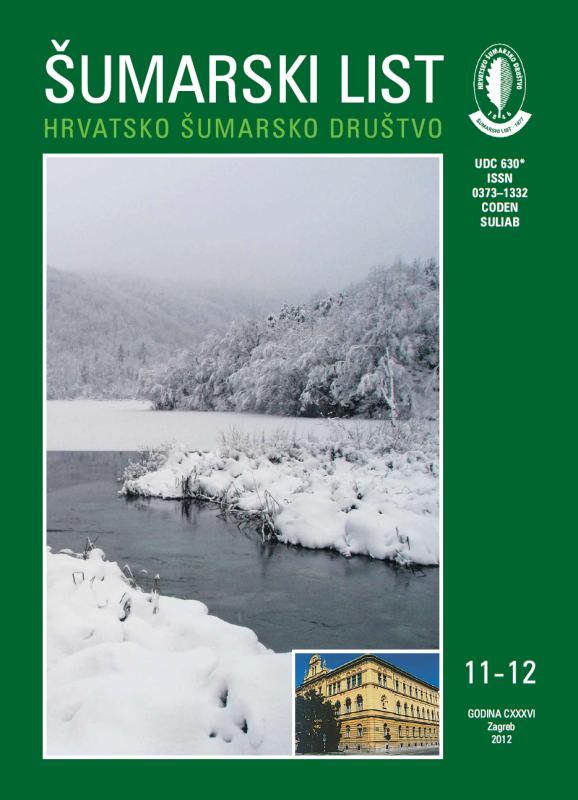
broj: 11-12/2012
pdf (4,44 MB) |
|
||||||||||||||
| RIJEČ UREDNIŠTVA | ||
| Uredništvo | ||
| AT THE END OF THE YEAR pdf HR EN | 557 | |
| IZVORNI ZNANSTVENI ČLANCI | ||
| Jozo FRANJIĆ, Željko ŠKVORC, Daniel KRSTONOŠIĆ, Krunoslav SEVER, Ivana ALEŠKOVIĆ | UDK 630*165+187 (001) | |
| VEGETATION FEATURES OF LITTORAL BEECH FORESTS (Seslerio autumnali-Fagetum M. Wraber ex Borhidi 1963) AND PREMONTANE BEECH FORESTS (Ranunculo platanifoliae-Fagetum Marinček et al. 1993) IN THE AREA OF UČKA NATURE PARK pdf HR EN | 559 | |
| Marilena IDŽOJTIĆ, Marko ZEBEC, Igor POLJAK, Zlatko ŠATOVIĆ, Zlatko LIBER | UDK 630*165 (Castanea sativa Mill.) (001) | |
| ANALYSIS OF THE GENETIC DIVERSITY OF "LOVRAN MARRON" (Castanea sativa Mill.) USING MICROSATELLITE MARKERS pdf HR EN | 579 | |
| Dalibor BALLIAN, Faruk BOGUNIĆ, Osman MUJEZINOVIĆ, Davorin KAJBA | UDK 630*165 (Fagus sylvatica L.) (001) | |
| GENETIC DIFFERENTIATION OF EUROPEAN BEECH (Fagus sylvatica L.) IN BOSNIA AND HERZEGOVINA pdf HR EN | 589 | |
| PRETHODNO PRIOPĆENJE | ||
| Stefan WIRTH Milan PERNEK | UDK 630*443 | |
| FIRST RECORD OF THE MITE Histiostoma ulmi IN SILVER FIR AND INDICATION OF A POSSIBLE PHORETIC DISPERSAL BY THE LONGHORN BEETLE Acanthocinus reticulatus pdf HR EN | 599 | |
| STRUČNI ČLANCI | ||
| Damira TAFRA, Marija PANDŽA, Milenko MILOVIĆ | UDK 630*174 | |
| WOODY PLANTS OF THE OMIŠ pdf HR EN | 607 | |
| Summary: This paper presents a list of woody plant taxa and their dendrological and horticultural qualities. Taxonomical, ecological and phytogeographical analysis cover 239 of taxa. The results are given in Tables 1–2. There are 72 families, 156 genera and 239 of taxa in total (Table 1), twenty of them belonging to gymnosperms and 219 to angiosperms. The angiosperms group is largely dominated by the dicotyledones (205 taxa; 85.87 %). Out of 72 families, four of them have more than 10 species and subspecies. The largest number of species belongs to the Rosaceae (33 taxa; 13.80 %), Fabaceae (14 taxa; 5.86 %), Oleaceae (13 taxa; 5.44 %) and Lamiaceae (11 taxa; 4.60 %) families. Species from the above mentioned four families make 29.71 % of the total woody plants of the Omis. The composition of woody plants of the Omis is quite heterogeneous which is obvious from a large number of families (72) and genera (156). There is only 1.53 species per genus and 3.32 species per family. The most frequent genera are Prunus (11 taxa), Tamarix (5 taxa) whereas Acer, Lonicera, Populus, Rosa and Ulmus are present with 4 taxa. Analysis of dendroflora due to habitat type (acc. to Erhardt et al. 2002) indicates the dominance of shrubby forms (132 of taxa; 55.23 %), following by the trees (83; 34.73 %), while the group of woody climbing plants is the least represented (24; 10.04 %). Within the dendroflora of Omis, there are 89 (37.20 %) autochthonous and 150 (62.80 %) allochthonous species. Of the total number of taxa of autochthonous dendroflora, 43 of taxa (48.31 %) occur in the wild, 24 (26.97 %) grow only in culture, while 22 of taxa (24.72 %) occur in culture as well as in the natural and seminatural vegetation. The allochthonous ones are dominated by species in culture (121 species; 80.67 %), casual (21; 14.00 %) and 8 naturalised. These results are consistent with those relating to other parts of Croatia. An increased presence of allochthonous plants, especially neophytes, is a reliable indicator of the intensity of the anthropogenic impact to the flora. The majority of all the allochthonous species that appear on different areas never manage to get naturalised so their existance depends on the re-appearance of the diaspora. A small number of the naturalised species has the ability of invasively spreading beyond the place of their original appearance. In woody plants of the Omis, naturalised species are represented by 3 species (Agava americana, Morus alba and Prunus cerasifera) and the invasive ones by 5 species (Acer negundo, Ailanthus altissima, Amorpha fruticosa, Broussonetia papyrifera and Robinia pseudoacacia). Although only a small number of species brought into the culture has the ability to domesticate and spread invasively into the surrounding habitats, some of them can cause serious eco-system irregularities. In the region of Omis especially dangerous could become Amorpha fruticosa covering more and more areas along the Cetina river thus suppressing native species. Knowing that invasive species mainly domesticate and spread through horticulture it is advisable to avoid them in horticulture. Regarding geographical origins (Table 2), the allochthonous dendroflora of Omis is dominated by species from Asia (65 taxa; 43.33 %), America (23.33 %) and Europe (12.80 %). The most frequent Asian species in the horticulture are those coming from China (Buddleja davidii, Kerria japonica, Rosa banksiae etc). Quite a significant number of woody species, autochthonous as well as allochthonous, and their high diversity attribute to an exceptional value of the dendroflora of Omis. The research results relating to woody plants of the Omis and other Croatian regions indicate an unjustified long-term neglect of autochthonous species in culture in comparison with the allochthonous ones even though they have adjusted themselves to the existing climate conditions which makes the maintenance of horticultural objects easier, not to mention that their decorative qualities match those of the allochthonous species. Key words: allochthonous and autochthonous dendroflora; town of Omiš | ||


